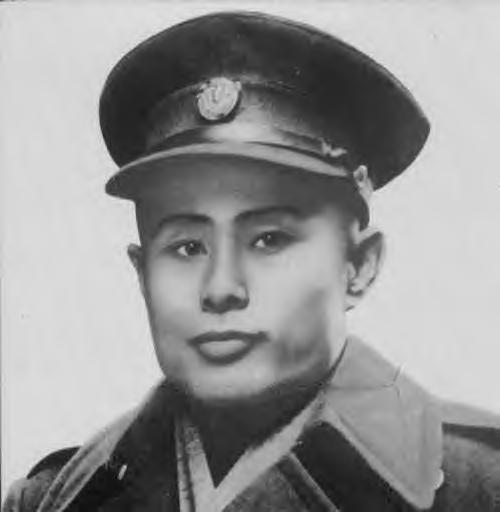Important Dates of Bogyoke Aung San, Father of Myanmar (February of 1915 - July of 1947)
13th February 1915 Born at Natmauk, a township in Magwe district, central Burma.
1932 Matriculated in the "A" category with distinctions in Burmese and Pali.
1935-36 Elected to the executive committee of the Rangoon University Students' Union and became the editor of the Students' Union Magazine.
February 1936 Expelled from the university for publication of the article "Hell Hound at Large" in the union magazine. Expulsion of Ko Aung San and Ko Nu from the university led to the university strike. Later, the government conceded strikers' demands and retracted expulsion orders.
1938 Elected as president of the Rangoon University Students' Union and the All Burma Student's Union. Appointed as a student representative in "Rangoon University Act Amendment Committee" by the government.
October 1938 Joined Dohbama Asi-ayone ("We-Burmese" Organization) and became Thakin Aung San.
1938 to August 1940 Acted as the Head Office General Secretary of Dohbama Asi-ayone.
1938-39 Countrywide strikes known as Revolution of Year 1300 (Burmese calendar year).
1939 to 1940 Helped to found Bama-htwet-yat Ghine (Freedom Bloc) and became the general secretary.
March 1940 Attended Indian National Congress Assembly in Rangar?, India.
1940 Went underground due to arrest warrant issued by the British government.
August 1940 Left for Burma and reached Amoy, China and later to Tokyo, Japan.
February 1941 Came back to Burma with offer of arms and money support from the Japanese for uprising.
1941 Arrived in Japan for military training together with the first batch of the Thirty Comrades.
December 1941 Founded Burmese Independence Army (BIA) in Bangkok, Thailand with the help of the Japanese and became chief-of-staff Major-General Aung San (a.k.a. Bo Teza).
March 1942 Rangoon, capital of Burma, fell to the Japanese Army. The Japanese military administration took over Burma.
July 1942 Reorganized BIA and become Burma Defence Army (BDA). Appointed as Commander-in-Chief Colonel Aung San.
6th September 1942 Married with Daw Khin Kyi.
March 1943 Promoted to become Major-General Aung San of BDA.
1943 Invited to Japan and decorated by the Emperor with "Order of the Rising Sun".
1st August 1943 Burma was declared an independent nation and Major-General Aung San became the War Minister.
1943 BDA was renamed as Burma National Army (BNA).
November 1943 The British troops hiding in hills of Burma received Aung San's plan to turn his forces against the Japanese.
1st August 1944 Declared Burma's independence status as fake in independence day anniversary speech.
August 1944 Founded Anti-Fascist Organization (AFO) and became the military leader of the organization.
27th March 1945 Burmese troops throughout the country rose up against the Japanese.
15th May 1945 Met with William Slim of the Fourteenth Army.
15th June 1945 Victory parade was held in Rangoon. The Burmese forces participated alongside the British and Allied forces.
August 1945 The Japanese forces surrendered.
August 1945 AFO was expanded and renamed as Anti-Fascist People's Freedom League (AFPFL).
1945 BNA was renamed as Patriotic Burmese Forces (PBF).
September 1945 Signed an agreement to merge PBF with Burma Army under British command during a meeting in Kandy, Ceylon.
October 1945 Civil government was restored with Dorman-Smith as the governor of Burma.
January 1946 Elected as president of the AFPFL.
September 1946 Appointed as Deputy Chairman of the Executive Council of Burma with portfolios for defence and external affairs.
2nd January 1947 Met with Prime Minister Jawaharlal Nehru of India in New Delhi, India during his way to London.
27th January 1947 Signed "Aung San–Attlee Agreement" in London guaranteeing Burma's independence within a year.
12th February 1947 Signed "Panglong Agreement" with leaders from national groups expressing solidarity and support for united Burma in Panglong, Shan State, Burma.
April 1947 AFPFL won 196 of 202 seats in the election for a constituent assembly.
June 1947 Convened series of conferences at the Sorrenta Villa in Rangoon for rehabilitation of the country.
13th July 1947 Gave last public speech urging Burmese people to mend their ways and urge them for more discipline.
19th July 1947 Assassinated during the Executive Council meeting together with six other Councillors, including his elder brother, U Ba Win.
U Saw, a former Prime Minister, was found guilty of the abetment and executed.
4th January 1948 Burma regained its independence.
|
 |